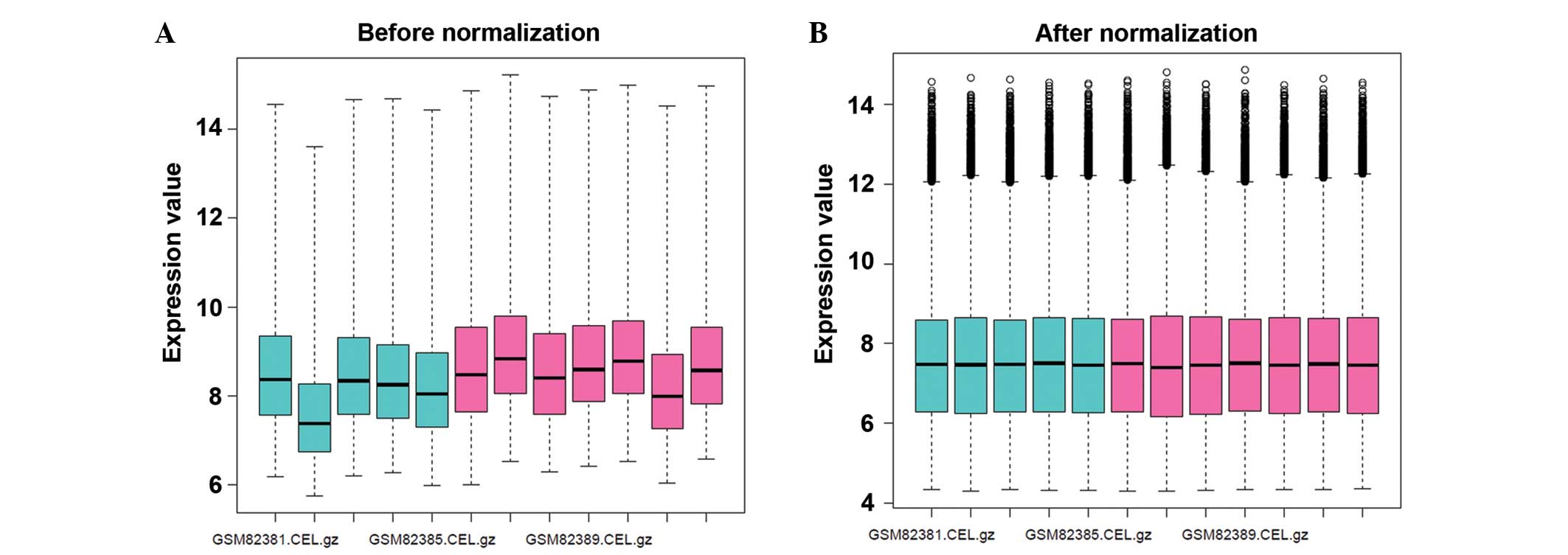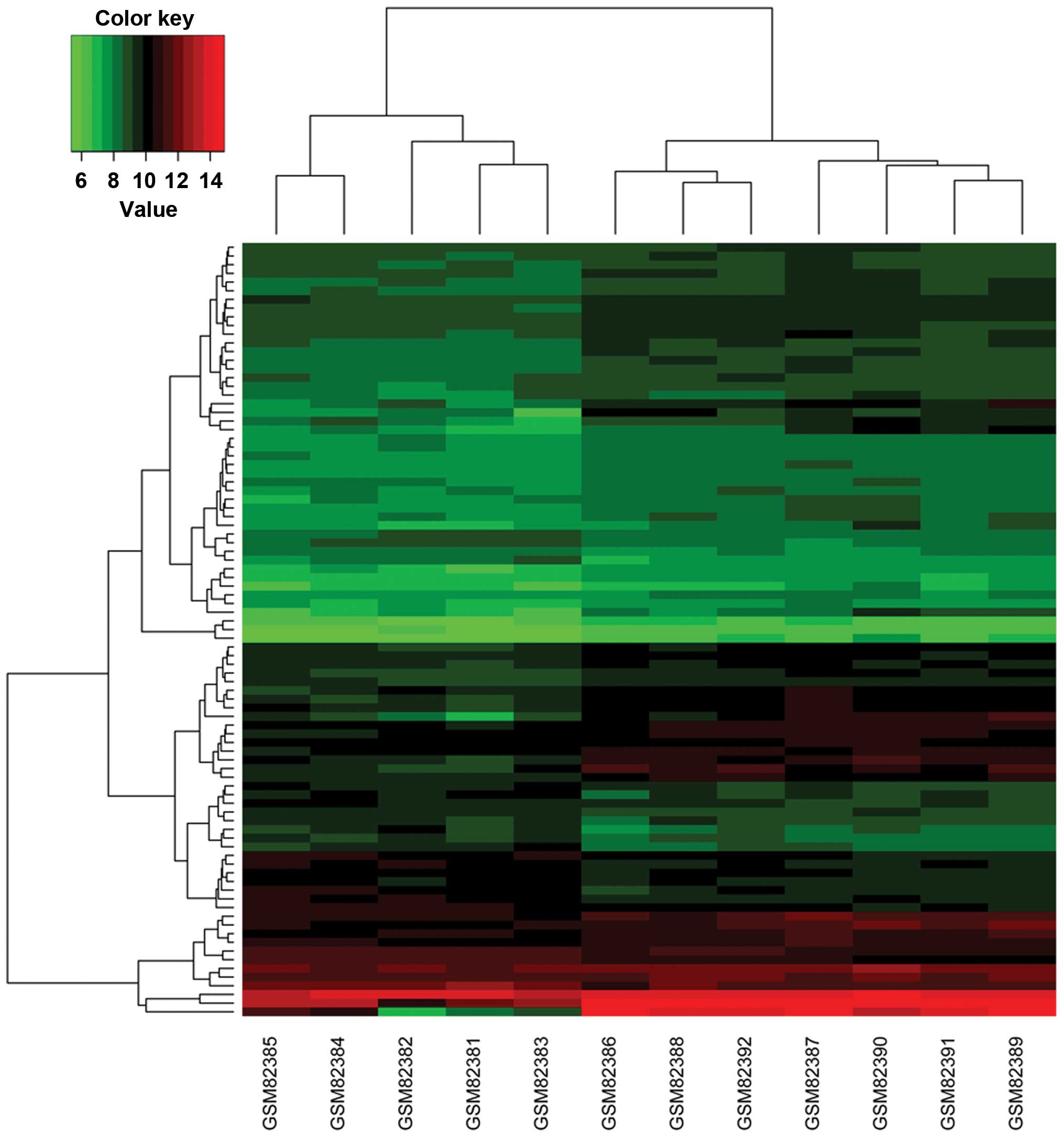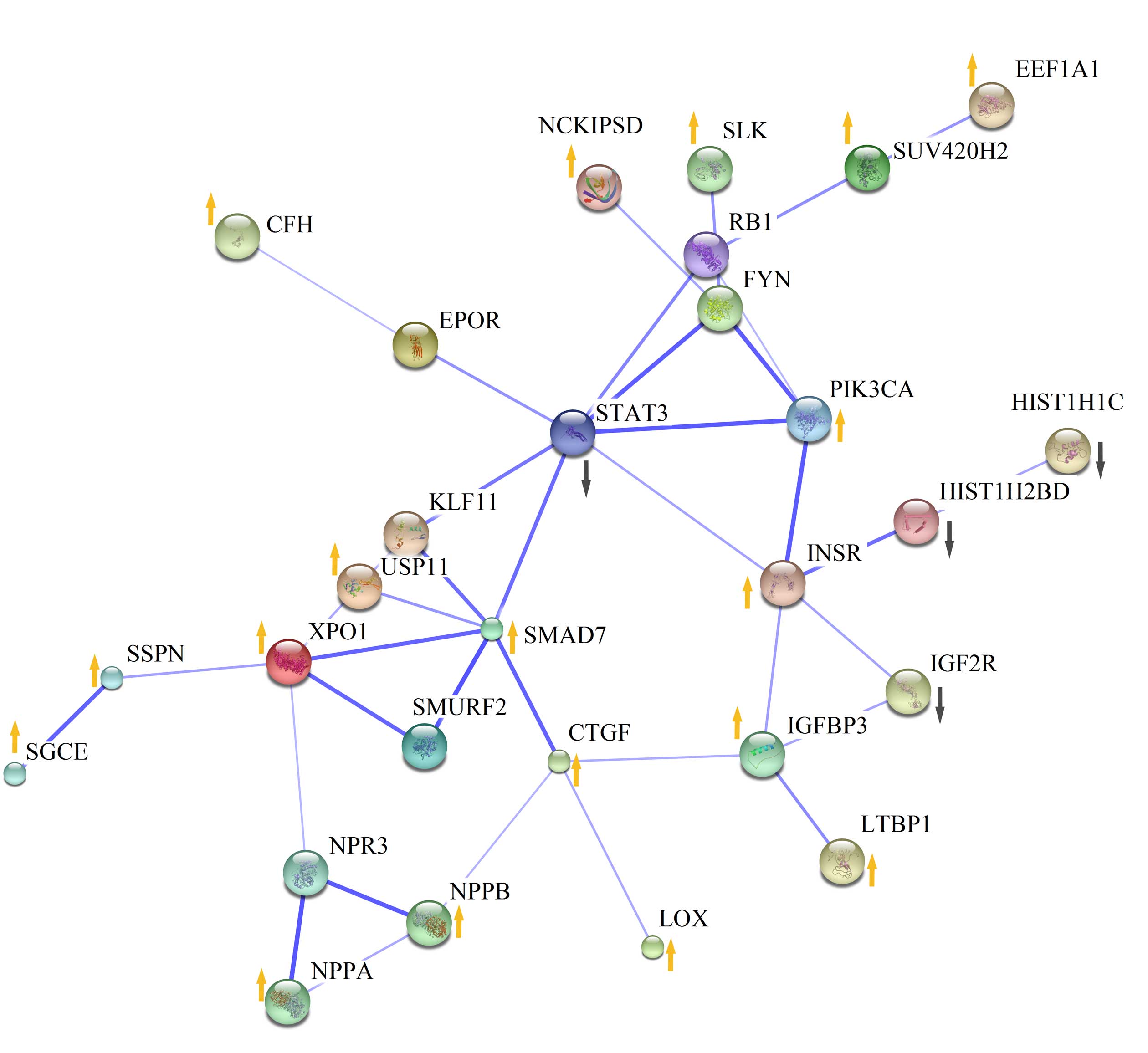|
1
|
Hershberger RE, Hedges DJ and Morales A:
Dilated cardiomyopathy: The complexity of a diverse genetic
architecture. Nat Rev Cardiol. 10:531–547. 2013. View Article : Google Scholar : PubMed/NCBI
|
|
2
|
Jefferies JL and Towbin JA: Dilated
cardiomyopathy. Lancet. 375:752–762. 2010. View Article : Google Scholar : PubMed/NCBI
|
|
3
|
Goldberger JJ, SubaÄ H, Patel T, Cunnane R
and Kadish AH: Sudden cardiac death risk stratification in patients
with nonischemic dilated cardiomyopathy. J Am Coll Cardiol.
63:1879–1889. 2014. View Article : Google Scholar : PubMed/NCBI
|
|
4
|
Gerull B, Gramlich M, Atherton J, McNabb
M, Trombitás K, Sasse-Klaassen S, Seidman JG, Seidman C, Granzier
H, Labeit S, et al: Mutations of TTN, encoding the giant muscle
filament titin, cause familial dilated cardiomyopathy. Nat Genet.
30:201–204. 2002. View
Article : Google Scholar : PubMed/NCBI
|
|
5
|
Villard E, Duboscq-Bidot L, Charron P,
Benaiche A, Conraads V, Sylvius N and Komajda M: Mutation screening
in dilated cardiomyopathy: Prominent role of the beta myosin heavy
chain gene. Eur Heart J. 26:794–803. 2005. View Article : Google Scholar : PubMed/NCBI
|
|
6
|
Taylor MR, Slavov D, Ku L, Di Lenarda A,
Sinagra G, Carniel E, Haubold K, Boucek MM, Ferguson D, Graw SL, et
al: Prevalence of desmin mutations in dilated cardiomyopathy.
Circulation. 115:1244–1251. 2007.PubMed/NCBI
|
|
7
|
Schmidt HH and Lochs H: Lamin A/C gene
mutation associated with dilated cardiomyopathy with variable
skeletal muscle involvement. Circulation. 103:E202001. View Article : Google Scholar : PubMed/NCBI
|
|
8
|
Frazier AH, Ramirez-Correa GA and Murphy
AM: Molecular mechanisms of sarcomere dysfunction in dilated and
hypertrophic cardiomyopathy. Prog Pediatr Cardiol. 31:29–33. 2011.
View Article : Google Scholar : PubMed/NCBI
|
|
9
|
Kamisago M, Sharma SD, DePalma SR, Solomon
S, Sharma P, McDonough B, Smoot L, Mullen MP, Woolf PK, Wigle ED,
et al: Mutations in sarcomere protein genes as a cause of dilated
cardiomyopathy. N Engl J Med. 343:1688–1696. 2000. View Article : Google Scholar : PubMed/NCBI
|
|
10
|
Arbustini E, Diegoli M, Fasani R, Grasso
M, Morbini P, Banchieri N, Bellini O, Dal Bello B, Pilotto A,
Magrini G, et al: Mitochondrial DNA mutations and mitochondrial
abnormalities in dilated cardiomyopathy. Am J Pathol.
153:1501–1510. 1998. View Article : Google Scholar : PubMed/NCBI
|
|
11
|
Hayashi M, Imanaka-Yoshida K, Yoshida T,
Wood M, Fearns C, Tatake RJ and Lee JD: A crucial role of
mitochondrial Hsp40 in preventing dilated cardiomyopathy. Nat Med.
12:128–132. 2006. View
Article : Google Scholar : PubMed/NCBI
|
|
12
|
Kawahara C, Tsutamoto T, Nishiyama K,
Yamaji M, Sakai H, Fujii M, Yamamoto T and Horie M: Prognostic role
of high-sensitivity cardiac troponin T in patients with nonischemic
dilated cardiomyopathy. Circ J. 75:656–661. 2011. View Article : Google Scholar : PubMed/NCBI
|
|
13
|
Ohtsuka T, Nishimura K, Kurata A, Ogimoto
A, Okayama H and Higaki J: Serum matrix metalloproteinase-3 as a
novel marker for risk stratification of patients with nonischemic
dilated cardiomyopathy. J Card Fail. 13:752–758. 2007. View Article : Google Scholar : PubMed/NCBI
|
|
14
|
Terasaki F, Okamoto H, Onishi K, Sato A,
Shimomura H, Tsukada B, Imanaka-Yoshida K, Hiroe M, Yoshida T,
Kitaura Y, et al: Higher serum tenascin-C levels reflect the
severity of heart failure, left ventricular dysfunction and
remodeling in patients with dilated cardiomyopathy. Circ J.
71:327–330. 2007. View Article : Google Scholar : PubMed/NCBI
|
|
15
|
Barrans JD, Allen PD, Stamatiou D, Dzau VJ
and Liew CC: Global gene expression profiling of end-stage dilated
cardiomyopathy using a human cardiovascular-based cDNA microarray.
Am J Pathol. 160:2035–2043. 2002. View Article : Google Scholar : PubMed/NCBI
|
|
16
|
Barth AS, Kuner R, Buness A, Ruschhaupt M,
Merk S, Zwermann L, Kääb S, Kreuzer E, Steinbeck G, Mansmann U, et
al: Identification of a common gene expression signature in dilated
cardiomyopathy across independent microarray studies. J Am Coll
Cardiol. 48:1610–1617. 2006. View Article : Google Scholar : PubMed/NCBI
|
|
17
|
Camargo A and Azuaje F: Identification of
dilated cardiomyopathy signature genes through gene expression and
network data integration. Genomics. 92:404–413. 2008. View Article : Google Scholar : PubMed/NCBI
|
|
18
|
Gautier L, Cope L, Bolstad BM and Irizarry
RA: Affy-analysis of Affymetrix GeneChip data at the probe level.
Bioinformatics. 20:307–315. 2004. View Article : Google Scholar : PubMed/NCBI
|
|
19
|
Gentleman RC, Carey VJ, Bates DM, Bolstad
B, Dettling M, Dudoit S, Ellis B, Gautier L, Ge Y, Gentry J, et al:
Bioconductor: Open software development for computational biology
and bioinformatics. Genome Biol. 5:R802004. View Article : Google Scholar : PubMed/NCBI
|
|
20
|
Irizarry RA, Hobbs B, Collin F,
Beazer-Barclay YD, Antonellis KJ, Scherf U and Speed TP:
Exploration, normalization and summaries of high density
oligonucleotide array probe level data. Biostatistics. 4:249–264.
2003. View Article : Google Scholar : PubMed/NCBI
|
|
21
|
Smyth GK: Limma: Linear models for
microarray data. Journal. 397–420. 2005.
|
|
22
|
Dennis G Jr, Sherman BT, Hosack DA, Yang
J, Gao W, Lane HC and Lempicki RA: DAVID: Database for annotation,
visualization and integrated discovery. Genome Biol. 4:P32003.
View Article : Google Scholar : PubMed/NCBI
|
|
23
|
Ashburner M, Ball CA, Blake JA, Botstein
D, Butler H, Cherry JM, Davis AP, Dolinski K, Dwight SS, Eppig JT,
et al: Gene ontology: Tool for the unification of biology. The gene
ontology. Nat Genet. 25:25–29. 2000. View
Article : Google Scholar : PubMed/NCBI
|
|
24
|
Kanehisa M and Goto S: KEGG: Kyoto
encyclopedia of genes and genomes. Nucleic Acids Res. 28:27–30.
2000. View Article : Google Scholar : PubMed/NCBI
|
|
25
|
Franceschini A, Szklarczyk D, Frankild S,
Kuhn M, Simonovic M, Roth A, Lin J, Minguez P, Bork P, von Mering C
and Jensen LJ: STRING v9.1: Protein-protein interaction networks,
with increased coverage and integration. Nucleic Acids Res.
41:(Database Issue). D808–D815. 2013. View Article : Google Scholar : PubMed/NCBI
|
|
26
|
Thakar A, Gupta P, Ishibashi T, Finn R,
Silva-Moreno B, Uchiyama S, Fukui K, Tomschik M, Ausio J and
Zlatanova J: H2A.Z and H3.3 histone variants affect nucleosome
structure: Biochemical and biophysical studies. Biochemistry.
48:10852–10857. 2009. View Article : Google Scholar : PubMed/NCBI
|
|
27
|
Backs J and Olson EN: Control of cardiac
growth by histone acetylation/deacetylation. Circ Res. 98:15–24.
2006. View Article : Google Scholar : PubMed/NCBI
|
|
28
|
Montgomery RL, Davis CA, Potthoff MJ,
Haberland M, Fielitz J, Qi X, Hill JA, Richardson JA and Olson EN:
Histone deacetylases 1 and 2 redundantly regulate cardiac
morphogenesis, growth and contractility. Genes Dev. 21:1790–1802.
2007. View Article : Google Scholar : PubMed/NCBI
|
|
29
|
Orphanides G and Reinberg D: A unified
theory of gene expression. Cell. 108:439–451. 2002. View Article : Google Scholar : PubMed/NCBI
|
|
30
|
Wyrick JJ, Holstege FC, Jennings EG,
Causton HC, Shore D, Grunstein M, Lander ES and Young RA:
Chromosomal landscape of nucleosome-dependent gene expression and
silencing in yeast. Nature. 402:418–421. 1999. View Article : Google Scholar : PubMed/NCBI
|
|
31
|
Touvron M, Escoubet B, Mericskay M,
Angelini A, Lamotte L, Santini MP, Rosenthal N, Daegelen D, Tuil D
and Decaux JF: Locally expressed IGF1 propeptide improves mouse
heart function in induced dilated cardiomyopathy by blocking
myocardial fibrosis and SRF-dependent CTGF induction. Dis Model
Mech. 5:481–491. 2012. View Article : Google Scholar : PubMed/NCBI
|
|
32
|
van Almen GC, Verhesen W, van Leeuwen RE,
van de Vrie M, Eurlings C, Schellings MW, Swinnen M, Cleutjens JP,
van Zandvoort MA, Heymans S and Schroen B: MicroRNA-18 and
microRNA-19 regulate CTGF and TSP-1 expression in age-related heart
failure. Aging Cell. 10:769–779. 2011. View Article : Google Scholar : PubMed/NCBI
|
|
33
|
Lang C, Sauter M, Szalay G, Racchi G,
Grassi G, Rainaldi G, Mercatanti A, Lang F, Kandolf R and Klingel
K: Connective tissue growth factor: A crucial cytokine-mediating
cardiac fibrosis in ongoing enterovirus myocarditis. J Mol Med
(Berl). 86:49–60. 2008. View Article : Google Scholar : PubMed/NCBI
|
|
34
|
Broglio F, Benso A, Arvat E, Aimaretti G,
Gottero C, Granata R, Boghen MF, Bobbio M, Camanni F and Ghigo E:
Normal IGF-I and enhanced IGFBP-3 response to very low rhGH dose in
patients with dilated cardiomyopathy. J Endocrinol Invest.
23:520–525. 2000. View Article : Google Scholar : PubMed/NCBI
|
|
35
|
Pucci A, Zanini C, Granata R, Ghignone R,
Iavarone A, Broglio F, Sorrentino P, Bergamasco L, Rinaldi M and
Ghigo E: Myocardial insulin-like growth factor-1 and insulin-like
growth factor binding protein-3 gene expression in failing hearts
harvested from patients undergoing cardiac transplantation. J Heart
Lung Transplant. 28:402–405. 2009. View Article : Google Scholar : PubMed/NCBI
|
|
36
|
Hassfeld S, Eichhorn C, Stehr K, Naegele
H, Geier C, Steeg M, Ranke MB, Oezcelik C and Osterziel KJ:
Insulin-like growth factor-binding proteins 2 and 3 are independent
predictors of a poor prognosis in patients with dilated
cardiomyopathy. Heart. 93:359–360. 2007. View Article : Google Scholar : PubMed/NCBI
|
|
37
|
Khodabukus A and Baar K: Glucose
concentration and streptomycin alter in vitro muscle function and
metabolism. J Cell Physiol. 230:1226–1234. 2015. View Article : Google Scholar : PubMed/NCBI
|
|
38
|
Van Linthout S, Seeland U, Riad A,
Eckhardt O, Hohl M, Dhayat N, Richter U, Fischer JW, Böhm M,
Pauschinger M, et al: Reduced MMP-2 activity contributes to cardiac
fibrosis in experimental diabetic cardiomyopathy. Basic Res
Cardiol. 103:319–327. 2008. View Article : Google Scholar : PubMed/NCBI
|
|
39
|
Lakdawala NK, Thune JJ, Colan SD, Cirino
AL, Farrohi F, Rivero J, McDonough B, Sparks E, Orav EJ, Seidman
JG, et al: Subtle abnormalities in contractile function are an
early manifestation of sarcomere mutations in dilated
cardiomyopathy. Circ Cardiovasc Genet. 5:503–510. 2012. View Article : Google Scholar : PubMed/NCBI
|
|
40
|
Parsons JT, Horwitz AR and Schwartz MA:
Cell adhesion: Integrating cytoskeletal dynamics and cellular
tension. Nat Rev Mol Cell Biol. 11:633–643. 2010. View Article : Google Scholar : PubMed/NCBI
|
|
41
|
Podewski EK, Hilfiker-Kleiner D, Hilfiker
A, Morawietz H, Lichtenberg A, Wollert KC and Drexler H:
Alterations in Janus kinase (JAK)-signal transducers and activators
of transcription (STAT) signaling in patients with end-stage
dilated cardiomyopathy. Circulation. 107:798–802. 2003. View Article : Google Scholar : PubMed/NCBI
|
|
42
|
Hilfiker-Kleiner D, Hilfiker A, Fuchs M,
Kaminski K, Schaefer A, Schieffer B, Hillmer A, Schmiedl A, Ding Z,
Podewski E, et al: Signal transducer and activator of transcription
3 is required for myocardial capillary growth, control of
interstitial matrix deposition, and heart protection from ischemic
injury. Circ Res. 95:187–195. 2004. View Article : Google Scholar : PubMed/NCBI
|
|
43
|
McMullen JR, Amirahmadi F, Woodcock EA,
Schinke-Braun M, Bouwman RD, Hewitt KA, Mollica JP, Zhang L, Zhang
Y, Shioi T, et al: Protective effects of exercise and
phosphoinositide 3-kinase (p110α) signaling in dilated and
hypertrophic cardiomyopathy. Proc Natl Acad Sci USA. 104:612–617.
2007. View Article : Google Scholar : PubMed/NCBI
|
|
44
|
Waardenberg AJ, Bernardo BC, Ng DC,
Shepherd PR, Cemerlang N, Sbroggiò M, Wells CA, Dalrymple BP,
Brancaccio M, Lin RC and McMullen JR: Phosphoinositide 3-kinase
(PI3K (p110α)) directly regulates key components of the Z-disc and
cardiac structure. J Biol Chem. 286:30837–30846. 2011. View Article : Google Scholar : PubMed/NCBI
|
|
45
|
Molina-Navarro MM, Roselló-Lletí E,
Tarazón E, Ortega A, Sánchez-Izquierdo D, Lago F, González-Juanatey
JR, García-Pavía P, Salvador A, Montero JA, et al: Heart failure
entails significant changes in human nucleocytoplasmic transport
gene expression. Int J Cardiol. 168:2837–2843. 2013. View Article : Google Scholar : PubMed/NCBI
|
|
46
|
Molina-Navarro MM, Triviño JC,
Martínez-Dolz L, Lago F, González-Juanatey JR, Portolés M and
Rivera M: Functional networks of nucleocytoplasmic
transport-related genes differentiate ischemic and dilated
cardiomyopathies. A new therapeutic opportunity. PLoS One.
9:e1047092014. View Article : Google Scholar : PubMed/NCBI
|
|
47
|
Dickover M, Hegarty JM, Ly K, Lopez D,
Yang H, Zhang R, Tedeschi N, Hsiai TK and Chi NC: The atypical Rho
GTPase, RhoU, regulates cell-adhesion molecules during cardiac
morphogenesis. Dev Biol. 389:182–191. 2014. View Article : Google Scholar : PubMed/NCBI
|
|
48
|
Zhang Y, Li W, Zhu M, Li Y, Xu Z and Zuo
B: FHL3 differentially regulates the expression of MyHC isoforms
through interactions with MyoD and pCREB. Cell Signal. 28:60–73.
2016. View Article : Google Scholar : PubMed/NCBI
|
|
49
|
Abraham WT, Gilbert EM, Lowes BD, Minobe
WA, Larrabee P, Roden RL, Dutcher D, Sederberg J, Lindenfeld JA,
Wolfel EE, et al: Coordinate changes in Myosin heavy chain isoform
gene expression are selectively associated with alterations in
dilated cardiomyopathy phenotype. Mol Med. 8:750–760.
2002.PubMed/NCBI
|

















